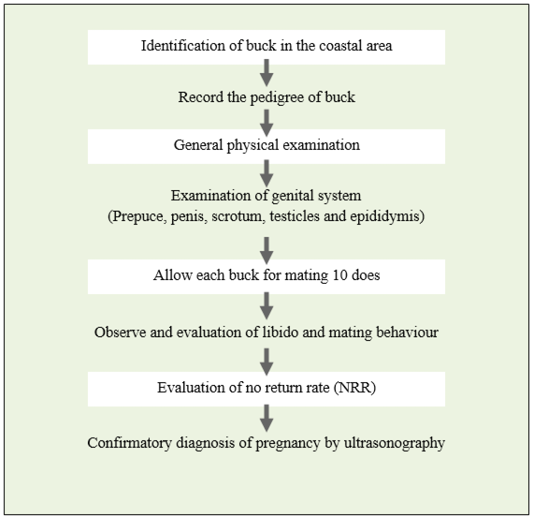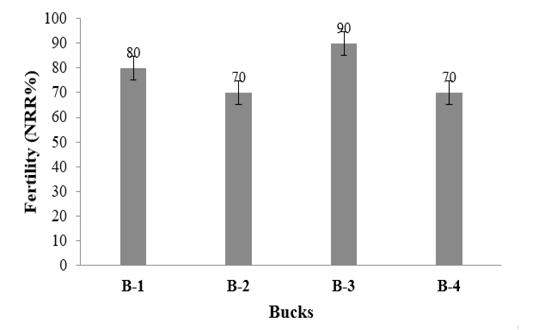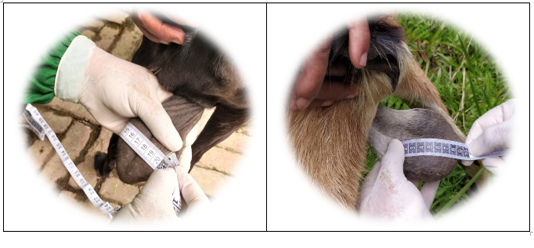Advances in Animal and Veterinary Sciences
Research Article
Selection of Indigenous Non Descriptive Breeding Buck Based on No Return Rate and Ultrasonograhic Pregnancy Diagnosis of Doe In Bangladesh
Ashit Kumar Paul1*, Nani Gopal Saha2, Dipa Rani Pal1
1Department of Medicine, Surgery and Obstetrics, 2Department of Animal Science and Animal Nutrition, Faculty of Animal Science and Veterinary Medicine, Patuakhali Science and Technology University, Outer Campus, Babugonj, Barishal-8210, Bangladesh
Abstract | Selection of buck is the starting point in goat development program.The aim of this study was to select of indigenous breeding buck at the Coastal areas of Bangladesh. A total of 20 bucks were examined and evaluated for the breeding efficiency considering the different factors such as pedigree, age, body weight, libido, hoof conformation, scrotal texture and circumference, no return rate etc. Out of these 20 bucks, 10 bucks were selected on the basis of scrotal circumference (SC) >18cm. Then these 10 bucks were under taking for checking their fertility through calculating the non-return rate (NRR).The SC of B-1, B-2, B-3 and B-4 were 20.2, 20.1, 21.2 and 20.2 cm, respectively. The mean ±SD of SC was 20.43±0.52. The testiculo-epididymal length (TEL) of B-1, B-2, B-3 and B-4 were 11.1, 10.8, 11.8 and 10.4 cm, respectively. The mean ±SD of TEL was 11.03±0.59. The NRR of B-1, B-2, B-3 and B-4 were 80%, 70%, 90% and 70%, respectively.In case of pregnancy per NRR in B-1, B-2, B-3 and B-4 were 100%, 100%, 89.89% and 85.71%, respectively.Conclusion: It may be concluded that the SC, TEL affect the breeding potentiality of buck. Further study with analysis of semen volume, morphology, sperm motility, mass activity, viability will be performed.
Keywords | Bucks, Coastal area, Semen, Conservation
Received | March 12, 2021; Accepted | March 17, 2021; Published | June 15, 2021
*Correspondence | Ashit Kumar Paul, Department of Medicine, Surgery and Obstetrics, Patuakhali Science and Technology University, Outer Campus, Babugonj, Barishal-8210, Bangladesh; Email: [email protected]
Citation | Paul AK, Saha NG, Pal DR (2021). Selection of indigenous non descriptive breeding buck based on no return rate and ultrasonograhic pregnancy diagnosis of doe in bangladesh. Adv. Anim. Vet. Sci. 9(7): 1020-1024.
DOI | http://dx.doi.org/10.17582/journal.aavs/2021/9.7.1020.1024
ISSN (Online) | 2307-8316; ISSN (Print) | 2309-3331
Copyright © 2021 Paul et al. This is an open access article distributed under the Creative Commons Attribution License, which permits unrestricted use, distribution, and reproduction in any medium, provided the original work is properly cited.
INTRODUCTION
Goat farming as small scale is very popular in Bangladesh. It is reared integrally with other farming system. The goat is reared as traditional system at the coastal region of Bangladesh. Commercial goat farming as large scale is very few. Rural women are taking care of goat beside their house hold works. Black Bengal is the only pure breed of Bangladesh. Most of the goats (90%) reared are Black Bengal (Amin et al., 2001), reputed for their prolificacy, fertility, early sexual maturity, adaptability to hot humid conditions and superior quality meat and skin (Devendra and Burns, 1983; Hussain, 1999; Amin et al., 2001). However the haphazard breeding system seriously abolishes our indigenous breed. The indigenous non descriptive breed is suitable and disease resistant of the climatic condition. The breed, at the coastal region, has found some dissimilarity from other parts of Bangladesh. The meat production and flesh quality at this region still unidentified. Although it was found high productivity and showed good response of hormonal synchronization (Paul et al., 2020).
Now a days it is found that the people of this region showing interest for artificial insemination (AI) of their doe. As it is not available throughout the country, so people are trying to bring in semen from the neighbouring country illegally. Already we have found some breed which people have been brought from India illegally. If the situation is going on in such way, then the specialty of this regional breed will be dissolved due to unplanned cross breeding with the local breed.
Selection of buck represents the starting point in goat development program (Sultana et al., 2013). Selection of male is much more important because a buck can produce thousands of kids a year through AI, therefore the main avenue for genetic improvement is the selection of breeding male (Ahmed and Islam, 1987). For better propagation of the species of goat, there should have good breeding buck. But unfortunately, there is severe shortfall of stud bucks all over the country, especially in the rural areas, where more than 80% goats are being reared by the farmers. It is evident that about 30% does remain without service due to lack of breeding buck available in the locality. In most situations, bucks are being kept by only a few lower cast people and animals are often genetically very poor with unknown pedigree. Moreover, same buck has been used generation after generation which has created greater chance of increasing inbreeding and hence lowering reproductive performances along with disseminating of various venereal and infectious diseases (Husain, 2007). In order to improve the genetic makeup of goats, the poor quality semen producing buck must be avoided from insemination. However, to my knowledge there is no study for the conservation of locally developed breed at the Coastal region. Therefore, the aim of this study is to select of local non descriptive breeding buck based on NRR.
MATERIALS AND METHODS
Location
The study was conducted at Barishal district (latitude: 22° 42’ 17.89” N Longitude: 90° 22’ 12.47” E) which is under coastal area of Bangladesh.
Study place
The study was conducted in the Theriogenology and Reproductive Biotechnology laboratory, Department of Medicine, Surgery and Obstetrics, Faculty of Animal Science and Veterinary Medicine, Patuakhali Science and Technology University, outer Campus, Babugonj, Barishal.
Selection and management of bucks
The breed of bucks and does of this study was non descriptive indigenous breed. A total of 20 bucks were examined and evaluated for breeding efficiency considering the different factors such as pedigree, age, body weight, libido, hoof conformation, scrotal texture and circumference. Out of these 20 bucks, 10 bucks were selected on the basis of scrotal circumference (SC) and testiculo-epididymal length (TEL). The bucks in between 2-3 years old and weighing 15 to 20 kg with good body condition were selected. They were maintained on natural grazing, with supplemented feeding (concentrate mixture composed of 25% crushed maize, 50% wheat bran, 20% soybean meal, 1% fish meal, 2% DCP Powder, 1.5% salt and 0.5% vitamin- mineral premix) at 250 g/ head / day. Water and a mineral salt lick were provided ad libitum. They were reared in same management system. All goats were dewormed (Renadex® Renata Animal Health, Dhaka, Bangladesh) every two months interval and injected 3ml vitamin ADE (Renasol AD3E® Renata Animal Health, Dhaka, Bangladesh) and B-complex (Multivit® vet, Square Pharmaceuticals limited, Dhaka, Bangladesh) at 5 days interval for three injections monthly during breeding.
Parameters measured
The characteristic parameters taken were as follows:
Age: The bucks’ ages were determined by records or history from the breeders and by dentition using the method specified by Wosu (2002).
Body weights: These were measured by using measuring Rondo tape (ACI Animal Health, Dhaka, Bangladesh). Briefly the animal was made to stand with head in normal position and with the four legs set squarely under the body. Rondo tape was passed tightly around the body just back of the shoulders at the smallest circumference and the corresponding weight on the tape was read off straight away (Wangchuk et al., 2018).
Body Condition Score: This was evaluated subjectively as described by Ford et al. (2009) and Okere et al. (2011). The scores ranged from 1=emaciated to 5=obese.
Scrotal Circumference: The largest diameter of the scrotum and testiculo-epidedymal length were measured using a flexible tape while ensuring the testes lie side by side to each other (Figure 1). Before measuring SC, scrotal shape, scrotal anatomy, scrotal content and testicular consistency were examined. Bucks with ovoid and long ovoid scrota which are undivided and split were considered normal. Scrotal content were palpated to observe freely moving testes. Testicular consistency was scored as 1=very soft, 2=soft, 3=normal, 4=hard and 5=very hard (Keith et al., 2009; Philip and Okere, 2011).
Detection of oestrous and breeding
The does were observed closely for detecting the signs of oestrous at 4 hours interval. The oestrous does were detected using a teaser buck for inducing male effect. The does were allowed for natural service 12-24 hours after the onset of oestrous.
Pregnancy diagnosis
Pregnancy of doe was diagnosed by abdominal scanning with B-mode ultra-sonogram machine (CONTECTm B-ultrasound diagnostic system, model CMS600P2VET, CONTEC Medical system Company Limited, China) after 28-30 days of natural service.
Experimental layout
The experimental layout is showed in Figure 2.

Figure 2: Experimental layout
Statistical Analysis
The recorded data were keyed in the Microsoft excel sheet. The average scrotal circumferential diameter and testicular length were calculated expressed mean±SD and the No return rate (NRR) was estimated using the following formula:

RESULT AND DISCUSSION
Effect of scrotal circumference and testiculo-epididymal length on selection of buck
The scrotal circumference (SC) and testiculo-epididymal length (TEL) are showed in Table 1. The SC of B-1, B-2, B-3 and B-4 were 20.2, 20.1, 21.2 and 20.2 cm, respectively. The mean ±SD of SC was 20.43±0.52. The TEL of B-1, B-2, B-3 and B-4 were 11.1, 10.8, 11.8 and 10.4 cm, respectively. The mean ±SD of TEL was 11.03±0.59. A measurement of scrotal circumference is an integral part of breeding soundness evaluation of animals with a pendulous scrotum, particularly in bulls (Jainudeen, 1993; Goyal and Memon, 2007). Furthermore, a measurement of the SC is viewed as a cheap, repeatable, and objective way to estimate sperm production. These finding has showed the similarities with Gemeda and Workalemahu (2017), who also observed the overall mean value of SC 20.8±1.94 and testicular length (TL) 4.97±0.79.It was also observed that the SC of Long-eared Somali (21.4 ± 1.67) breed was significantly (P< 0.05) higher than that of Afar (20.5 ± 2.10) and Woyto-Guji (20.6 ± 1.93) breeds, but there had been no significant (P >0.05) disparity between Afar and Woyto-Guji breeds (Gemeda and Workalemahu, 2017). Raji et al. (2008) reported SC of 23.99 ± 0.17 and 20.75 ± 0.25 cm in Red Sokoto and Borno White bucks, respectively, in Nigeria which are similar to the results in this study. Furthermore, the mean values of the SC in three breeds in the present study are higher than 15.73 cm and 17.15 ± 1.14 cm reported for African Dwarf bucks (Abu et al., 2016) and Shale bucks (Oyeyemi, 2012), respectively, but it was lower than 28 to 39cm in Nubian buck (Goyal and Memon, 2007). These differences might be due to the effect of genotype or breed; similar reports of differences among breeds have been reported in goats (Raji et al., 2008).
Table 1: Effect of scrotal circumference and testicular length on selection of buck
| Buck No. | Scrotal circumference (cm) | Testiculo-epididymal length (cm) |
| B-1 | 20.2 | 11.1 |
| B-2 | 20.1 | 10.8 |
| B-3 | 21.2 | 11.8 |
| B-4 | 20.2 | 10.4 |
| Mean ±SD | 20.43±0.52 | 11.03±0.59 |
No Return Rate of different buck
The fertility rate or NRR of different bucks is presented in Figure 3. The NRR of B-1, B-2, B-3 and B-4 were 80%, 70%, 90% and 70%, respectively.The result of the present study was in agreement with the findings of Sultana et al. (2013) who found NRR in B5 (85.71±7.99%) followed by B2 (80.00±6.02%), B3 (76.00±10.43%), B4 (63.26±6.98%) and B1 (62.96±6.72%) in different Black Bengal buck. The variation in fertility of bucks shows the individual breeding potentiality and efficiency of each buck. Paulenez et al. (2003) found 87% 25-day NRR in Norwegian dairy goats. This variation might be due to the fact that, they obtained conception rate by actual pregnancy diagnosis whereas, conception rate in this study was determined by non-return basis. Among the four bucks, B1 and B-3 were screened as the best performer whereas B-2 and B-4 were moderate performer.

Figure 3: No return rate of different bucks
Buck performance on pregnancy rate of doe
The pregnancy of the doe was confirmed using B-mode ultrasonogram machine (Figure 4). The pregnancy rate of doe in B-1, B-2, B-3 and B-4 were 80%, 70%, 80% and 60%, respectively (Table 2). In case of pregnancy per NRR in B-1, B-2, B-3 and B-4 were 100%, 100%, 89.89% and 85.71%, respectively. There was no significance (p>0.05) difference among the buck. Yotov et al. (2016) found that the overall pregnancy rate in natural estrous group (60%) was significantly (P < 0.05) higher than (37%) in goats without GnRH treatment. It is known that artificial insemination at the start of the standing estrus results in decrease of a pregnancy rate than that of natural service (Arrebola et al., 2014; Yotov et al., 2016).
Table 2: Buck performance based on pregnancy rate of doe
| Buck No. | NNR (%) | Pregnancy rate (%) of doe | Pregnancy per NRR (%) |
| B-1 | 80 | 80 | 100 |
| B-2 | 70 | 70 | 100 |
| B-3 | 90 | 80 | 88.89 |
| B-4 | 70 | 60 | 85.71 |
P >0.05
CONCLUSION
It may be concluded that the SC, TEL affect the breeding potentiality of buck. According to findings of the NRR and results of confirmatory pregnancy of doe, these bucks may be selected for breeding. However, semen volume, morphology, sperm motility, mass activity, viability will be calculated in next study.
ACKNOWLEDGEMENTS
The authors are very grateful to the Ministry of Science and Technology for the Research Contract Proposal under special allocation for Science and Technology Ministry in the financial year 2019-2020, sanction order number SL-250, BS-250.
CONFLICT OF INTEREST
The authors have declared no conflict of interest.
authors contribution
All authors contributed equally to the manuscript.
REFERENCES








